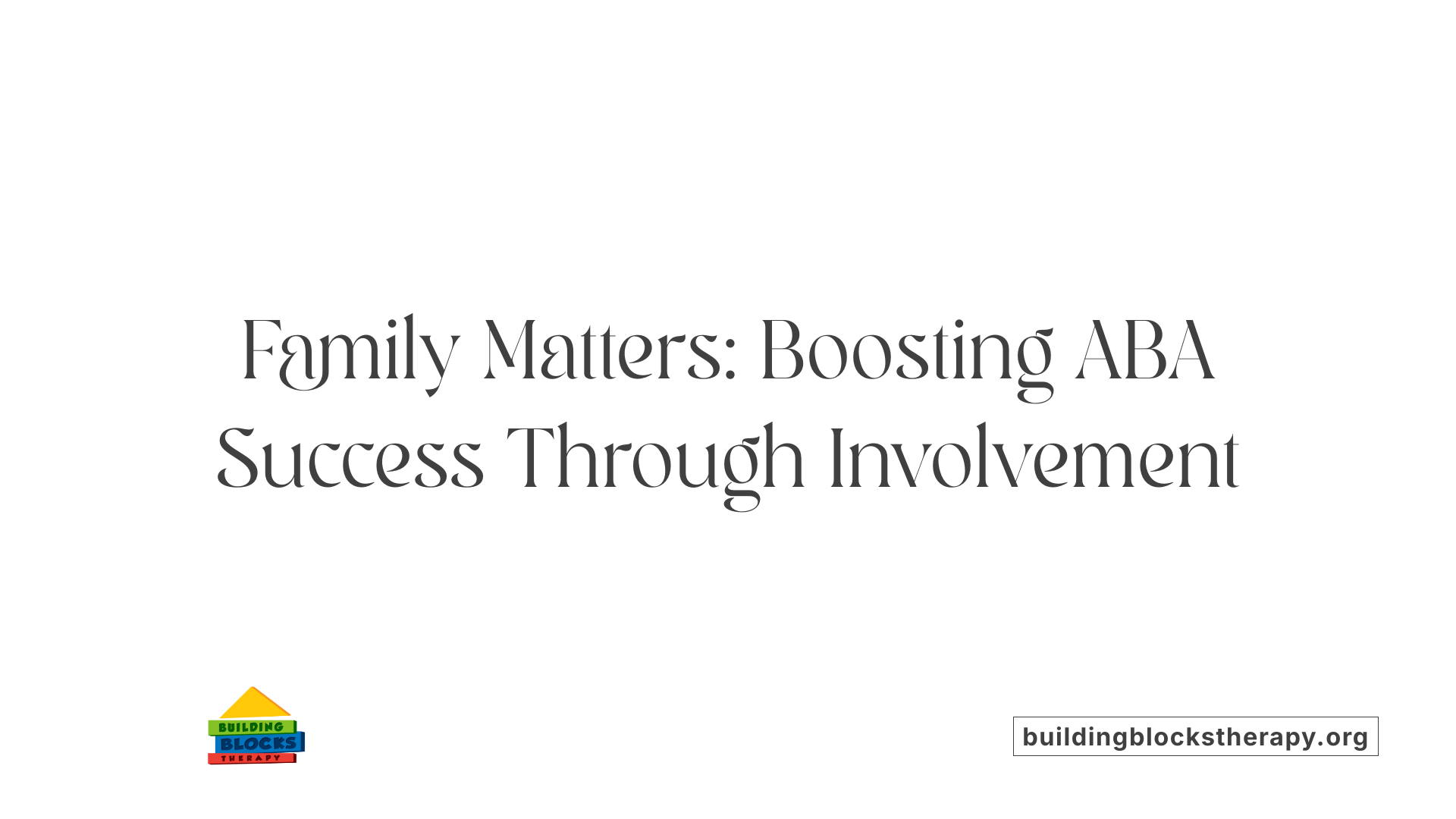Understanding the Power of ABA Therapy
Applied Behavior Analysis (ABA) therapy stands as a cornerstone in behavioral intervention, particularly for individuals with autism spectrum disorder. Rooted in behavioral science and driven by data, ABA therapy systematically fosters positive behavior changes, enabling individuals to develop essential life skills and enhance their quality of life. This article explores how ABA therapy supports meaningful behavioral transformation through its personalized, scientifically grounded methods and collaborative approach.
Defining ABA Therapy: Science Meets Behavior

What is Applied Behavior Analysis (ABA) therapy?
Applied Behavior Analysis (ABA) therapy is a scientifically supported approach that focuses on understanding and changing behavior through systematic and data-driven methods. It aims to increase helpful behaviors such as communication, social skills, and independence while reducing harmful or challenging behaviors. This makes ABA a powerful tool in various settings, including homes and schools, tailored to individual needs by certified behavior analysts.
Scientific basis and principles
ABA therapy is rooted in behavioral psychology, particularly the science of behavior analysis. It operates on several foundational principles:
- Applied: ABA focuses on real-life situations and meaningful behaviors.
- Behavioral: It targets observable and measurable actions.
- Analytic: It uses data to guide interventions and track progress.
- Technological: Procedures are clearly defined to be replicable.
- Conceptually Systematic: Strategies rely on established behavioral concepts.
- Effective: Designed to produce significant behavioral improvements.
- Generality: Skills learned are generalized across settings and time.
Focus on behavior modification
ABA therapy works by understanding how behavior operates and applying strategies to change it. Central to this process is positive reinforcement, where desirable behaviors are encouraged through rewards such as verbal praise, preferred activities, or tangible incentives. Techniques like prompting (guiding behaviors), shaping (gradually reinforcing closer approximations to a behavior), and generalization (applying skills in various contexts) are commonly used.
Use of data-driven methods
A hallmark of ABA is its reliance on continuous data collection and analysis during therapy sessions. This data-driven approach ensures interventions are tailored and adjusted based on individual progress. Certified Behavior Analysts (BCBAs) design treatment plans informed by this data, ensuring measurable and meaningful outcomes.
Application of the ABC model
ABA therapists frequently use the Antecedent-Behavior-Consequence (ABC) model to understand and modify behaviors. This model breaks down behavior into three parts:
| Component | Description | Purpose in ABA Therapy |
|---|---|---|
| Antecedent | What happens immediately before the behavior | Identifies triggers or cues for behavior |
| Behavior | The observable action or response | The specific behavior targeted for change |
| Consequence | What follows the behavior | Reinforces or discourages the behavior |
By analyzing this sequence, therapists can develop strategies to encourage positive behaviors and reduce undesirable ones.
ABA therapy’s scientific foundation and personalized approach make it highly effective in producing meaningful behavior changes, particularly for individuals with autism spectrum disorder. This therapy exemplifies how evidence-based science can directly improve everyday lives.
Historical Roots and Evolution of ABA Therapy
Origin of ABA in the 1960s
Applied Behavior Analysis (ABA) therapy was developed in the 1960s, marking a significant advancement in behavioral science. This approach is grounded in behavioral psychology and focuses on observable behaviors and their relationships with environmental factors.
Dr. Ole Ivar Lovaas' Pioneering Work
Dr. Ole Ivar Lovaas played a central role in the origin of ABA therapy. He was among the first to apply behavioral principles to children with autism, developing methods that systemically analyze and modify behavior. His early work laid the foundation for the structure and techniques used in ABA today.
Initial Focus on Children with Autism
ABA therapy initially targeted children diagnosed with autism spectrum disorder. The focus was on improving social, communication, and daily living skills by using a scientific approach to behavior modification. This targeted intervention aimed to foster independence and adaptive skills through consistent positive reinforcement.
Expansion to Various Developmental and Behavioral Challenges
Since its inception, ABA has expanded beyond autism to support a broad range of developmental and behavioral issues. Today, it is used in schools, homes, and clinical settings to address diverse goals, including academic performance, independence, and social integration. This evolution reflects the adaptability and widespread acceptance of ABA as an effective treatment method.
Core Techniques and Therapeutic Practices in ABA
What are the Positive Reinforcement Techniques in ABA?
Positive reinforcement lies at the heart of ABA therapy. It involves encouraging desired behaviors by rewarding them with verbal praise, preferred activities, or tangible rewards. This strategy motivates individuals to repeat positive behaviors by linking them with enjoyable outcomes.
How Does Discrete Trial Training (DTT) Work?
Discrete Trial Training is a structured method that breaks down skills into small, teachable steps delivered systematically. Each trial includes a clear instruction, an opportunity for response, and a consequence such as reinforcement or correction. DTT is especially useful for teaching new skills by providing clear repetition and immediate feedback.
What is Pivotal Response Treatment (PRT)?
Pivotal Response Treatment adopts a more naturalistic approach than DTT. It targets "pivotal" areas like motivation and self-management that are central to broad behavioral improvements. PRT encourages learning through play and child-initiated activities, fostering engagement and generalization of skills.
How does ABA Use Prompting and Shaping?
Prompting involves providing cues or assistance to encourage a correct response, gradually reduced as independence grows. Shaping is the process of reinforcing successive approximations toward the target behavior. Both techniques help individuals acquire new skills step-by-step, increasing complexity as mastery develops.
How Does Generalization of Skills Across Environments Happen?
Generalization ensures that skills learned in therapy transfer to real-world settings such as home, school, and community. Therapists design interventions to promote practicing behaviors across different contexts, people, and situations, helping individuals apply new abilities broadly for lasting impact.
Tailoring ABA Therapy: Personalized Treatment Plans

What are the key components of an ABA therapy program?
An effective ABA therapy program begins with a thorough individualized assessment. Certified Behavior Analysts (BCBAs) collect detailed behavioral data to identify the unique needs, strengths, and challenges of the individual. This data-driven approach ensures that the therapy focuses on relevant behaviors and skill areas.
Following assessment, a structured treatment plan is developed. This plan sets measurable and specific objectives tailored to the individual’s goals, such as improving communication, social skills, or daily living abilities. The objectives are broken down into manageable steps, using techniques like Discrete Trial Training (DTT) and Pivotal Response Treatment (PRT).
Behavior analysis plays a central role in pinpointing what motivates the individual and which behaviors need modification. Tools like the ABC (Antecedent-Behavior-Consequence) model guide therapists in understanding behavior patterns and designing effective interventions.
Progress is continuously monitored through systematic data collection during therapy sessions. This ongoing evaluation allows therapists to adjust strategies promptly, ensuring the interventions remain effective and responsive to changing needs.
Family involvement is also a fundamental component. Caregivers receive training and guidance to reinforce skills at home, promoting generalization across environments and increasing the therapy’s success.
This personalized, evidence-based approach ensures that ABA therapy adapts to the individual, fostering meaningful improvements in communication, social interaction, independence, and overall quality of life.
How ABA Therapy Supports Individuals with Autism
Structured Approach to Increase Helpful Behaviors
ABA therapy provides a systematic and evidence-based framework aimed at increasing positive behaviors while reducing negative or challenging behaviors. By focusing on real-life applications, ABA helps individuals with autism develop skills that are directly relevant to their day-to-day activities and interactions.
Breaking Skills into Manageable Steps
A cornerstone of ABA is breaking down complex skills into smaller, achievable steps. This step-by-step process allows learners to acquire new abilities gradually and confidently. Each task is tailored to the individual's needs, ensuring personal relevance and maximizing learning potential.
Use of Positive Reinforcement to Motivate Learning
Positive reinforcement lies at the heart of ABA therapy. This may include rewards such as verbal praise, favorite activities, or tangible incentives. Reinforcement encourages individuals to repeat helpful behaviors, making learning a motivating and enjoyable experience.
Techniques Like Discrete Trial Training and Play-Based Strategies
ABA employs various techniques to teach skills effectively. Discrete Trial Training (DTT) is a structured method where tasks are broken down into trials with clear prompts and reinforcements. Alongside DTT, play-based strategies like Pivotal Response Treatment (PRT) use natural interactions and interests to foster skill acquisition in a less formal setting.
Development of Communication, Social, and Daily Living Skills
Through targeted interventions, ABA therapy promotes growth in multiple domains. Communication skills, such as language and expressive abilities, are enhanced alongside social skills like sharing and turn-taking. In addition, the therapy focuses on daily living skills including dressing, hygiene, and meal routines that improve independence.
Promotion of Independence and Community Participation
ABA aims to prepare individuals to navigate their environments confidently and independently. Teaching self-advocacy, decision-making, and everyday living skills supports greater autonomy. Furthermore, skills are generalized across settings, enabling participation in school, home, and community life.
| Aspect | Description | Examples |
|---|---|---|
| Structured Learning | Systematic breakdown of skills into smaller units | Discrete Trial Training |
| Reinforcement Strategies | Use of rewards to motivate and encourage positive behavior | Verbal praise, preferred activities |
| Skill Domains | Focus on communication, social interaction, and practical daily living skills | Making requests, social play |
| Individualized Interventions | Tailored programs based on a person's unique needs | Personalized goals and techniques |
| Promoting Independence | Teaching self-care, decision-making, and community engagement | Self-help tasks, community outings |
| Techniques Employed | Combination of structured trials and naturalistic play-based approaches | DTT, PRT |
Who Provides ABA Therapy? Roles and Expertise

Who provides ABA therapy?
ABA therapy is delivered by trained professionals who specialize in behavior analysis and intervention. The primary providers are Board Certified Behavior Analysts (BCBAs), who design, implement, and oversee treatment plans tailored to individual needs. These experts assess behaviors, develop intervention strategies, and monitor progress to ensure effective outcomes.
Behavior technicians and specialized therapists play critical roles in implementing ABA strategies as directed by BCBAs. They conduct therapy sessions, collect data, and work closely with clients to encourage skill development and behavioral improvements.
ABA therapy is offered across various settings, including licensed clinics, schools, homes, and increasingly through telehealth platforms. This flexibility helps cater to diverse client needs and environments.
Quality and standards in ABA services are maintained by accreditation from reputable organizations such as the Behavioral Health Center of Excellence (BHCOE). Accredited providers adhere to rigorous protocols emphasizing scientific rigor and ethical practice.
Family and caregiver involvement is fundamental in ABA therapy. Caregivers receive training and support to reinforce learned skills outside therapy sessions, maximizing positive behavioral changes and fostering progress in everyday life. This collaborative approach strengthens the impact of ABA interventions and promotes generalization of skills across settings.
Data-Driven Progress: Monitoring and Adaptation in ABA
Why is systematic data collection important in ABA therapy?
Systematic data collection is a foundational component of ABA therapy. It allows therapists to objectively observe, record, and quantify behaviors, ensuring interventions are tailored to each individual's needs. This evidence-based approach provides clear insights into how behaviors change over time and whether the therapy is effective.
How is behavioral data used to measure progress?
Behavioral data in ABA therapy captures specific, measurable outcomes such as increases in adaptive skills, communication, or social behaviors. Therapists analyze this data continually, which enables them to track progress accurately. For example, research has shown that children receiving consistent positive reinforcement through ABA demonstrate a 25–40% increase in adaptive skills within six months.
How does ABA therapy adjust based on outcomes?
ABA therapy is highly flexible and responsive to data. When behavioral data indicates that particular strategies are not effective, therapists modify interventions accordingly. This might involve changing reinforcement techniques, prompting methods, or adjusting goal complexity. Continuous monitoring ensures that therapy remains personalized and effective.
What ensures that developmental gains are measurable?
ABA therapy emphasizes objective and measurable goals by breaking down complex behaviors into specific, observable actions. Progress is documented systematically, using tools like the ABC (Antecedent-Behavior-Consequence) model. This structured tracking guarantees that improvements in areas such as social skills, communication, and independence are quantifiable.
How does data-driven practice promote accountability and evidence-based outcomes?
The data-centric nature of ABA therapy fosters transparency and accountability. Certified Behavior Analysts (BCBAs) use collected data for ongoing assessment, reporting progress, and validating intervention effectiveness. This scientifically grounded practice aligns with endorsements from reputable organizations, providing confidence in the therapy’s positive, evidence-based impact.
The Role of Family in Enhancing ABA Outcomes

Engagement of caregivers and family members
Family involvement is a vital component of Applied Behavior Analysis (ABA) therapy. Caregivers and family members are actively engaged throughout the process, ensuring the skills taught during therapy sessions are reinforced and generalized in everyday environments.
Training families to reinforce skills at home
ABA professionals, such as Certified Behavior Analysts (BCBAs), provide training and guidance to families so they can effectively support their loved ones' learning outside clinical settings. This coaching empowers families to use techniques like positive reinforcement, prompting, and shaping when interacting at home.
Collaboration between therapists and families
A strong partnership between therapists and families fosters consistent intervention strategies. Therapists systematically collect data and share progress reports, allowing families to understand advancements and contribute to goal-setting and treatment adjustments.
Extending learning beyond clinical sessions
ABA therapy emphasizes generalization, where skills learned during sessions are practiced across various settings, including home and school. Family participation plays a crucial role in embedding newly acquired skills into daily routines, enhancing retention and practical use.
Impact of family participation on long-term success
Research indicates that when families are actively involved, children and individuals receiving ABA therapy often experience greater improvement in communication, social skills, and independence. This partnership ultimately supports more sustained, positive outcomes and better life quality over time.
Long-Term Benefits: Beyond Childhood and Autism

How Does ABA Therapy Contribute to Lifelong Skills and Independence?
ABA therapy is designed to foster independence by teaching everyday living skills, self-advocacy, and decision-making. Through personalized treatment plans and positive reinforcement, individuals learn to develop essential skills that they carry into adulthood. This approach supports not only children but people of all ages, helping them gain confidence and autonomy.
In What Ways Does ABA Improve Social Integration and Communication?
A central focus of ABA is enhancing social skills and communication abilities, which are crucial for effective social integration. The therapy uses techniques such as prompting, shaping, and opportunities for generalization of skills in different environments. Improvements in these areas contribute significantly to better interaction with peers, family, and community members.
How Does ABA Support Individuals Beyond Early Childhood?
While early intervention (ideally ages 2 to 6) yields optimal outcomes, ABA therapy benefits individuals across the lifespan, including teenagers and adults. Tailored interventions can target communication, social skills, independence, and even academic performance, making ABA a versatile tool for ongoing development.
What Impact Does ABA Have on Academic and Daily Functioning?
ABA facilitates measurable progress academically by improving focus, task completion, and classroom behavior. It also boosts daily functioning through teaching life skills necessary for independent living. Data-driven assessments allow therapists to adjust strategies to meet evolving educational and personal needs effectively.
How Does ABA Therapy Enhance Overall Quality of Life?
Research shows that individuals receiving ABA demonstrate increased adaptive skills, leading to better social integration, increased independence, and improved communication. Long-term benefits include enhanced life skills and the ability to participate fully in community life, resulting in a higher quality of life.
| Aspect | Description | Benefit to Individual |
|---|---|---|
| Lifelong Skills | Teaching real-life skills like decision making and self-advocacy | Fosters independence and confidence |
| Social Integration | Improving communication and social skills | Enhances relationships and community involvement |
| Across All Ages | Providing tailored ABA interventions from early childhood to adulthood | Supports continuous personal growth |
| Academic & Daily Function | Boosts academic achievement and daily living skills | Promotes success in school and home environments |
| Quality of Life | Enhances adaptive skills and overall well-being | Leads to greater autonomy and life satisfaction |
The Lasting Impact of ABA Therapy on Positive Behavior Change
ABA therapy represents a scientifically validated, individualized approach that systematically promotes positive behavioral changes in individuals, especially those with autism spectrum disorder. By combining rigorous data analysis, evidence-based techniques, and strong family collaboration, ABA fosters the development of communication, social skills, independence, and adaptive behaviors. Its influence extends beyond childhood, offering foundational skills that enhance quality of life across the lifespan. As a comprehensive, holistic therapy rooted in behavioral science, ABA continues to transform lives by supporting meaningful and sustainable behavior change.
References
- What Makes ABA Effective for Behavior Change?
- 5 Benefits of ABA Therapy for Autistic Child
- ABA Therapy and Its Role in Positive Behavioral Change
- How ABA Therapy is Transforming the Lives of Children with ...
- Applied Behavior Analysis (ABA)
- Understanding ABA Therapy: What It Is and How It Works |
- ABA Therapy Goals: 25 Practical Examples & Timelines
- The Components of an ABA Program
- Applied Behavior Analysis (ABA)
- Applied Behavior Analysis (ABA)






